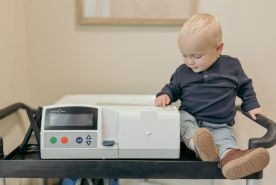What is Ultrafiltration?
Ultrafiltration is the removal of fluid from a patient and is one of the functions of the kidneys that dialysis treatment replaces. Ultrafiltration occurs when fluid passes across a semipermeable membrane (a membrane that allows some substances to pass through but not others) due to a driving pressure.
Ultrafiltration in Hemodialysis
In hemodialysis, fluid is removed by ultrafiltration using the dialysis membrane. The pressure on the dialysate side is lower so water moves from the blood (place of higher pressure) to the dialysate (place of lower pressure). This is how the hemodialysis treatment removes fluid.
The ultrafiltration rate, as well as length of dialysis treatment time, control the amount of fluid to be removed. Your dialysis staff will set the ultrafiltration rate of your treatment based on your fluid weight gain since your last treatment. The goal is to get to your target or “dry weight”. If you drink too much fluid between dialysis treatments and your body cannot tolerate a higher ultrafiltration rate because fluid is being removed too fast, you may experience low blood pressure and cramping. Additionally, you may require a longer dialysis treatment and/or an extra treatment day if the extra fluid cannot be removed safely at one time.
What can you do to help with ultrafiltration?
- Do not skip or shorten hemodialysis treatments – adequate dialysis is important for overall health
- Manage sodium and fluid in your diet. Talk to your dietitian about ways to limit salt and fluid intake (see Nutrition and Hemodialysis)
Ultrafiltration in Peritoneal Dialysis
Peritoneal dialysis (PD) removes fluid by ultrafiltration using the lining of your belly (called the peritoneal membrane). Water moves from the blood to the PD solution through the peritoneal membrane due to a type of sugar in the dialysate solution called dextrose.
Ultrafiltration can be increased by increasing the amount of dextrose in the PD solution. PD solutions are available with 3 different amounts of dextrose: 1.5%, 2.5%, and 4.25%. Your PD clinician may tell you to increase the dialysate dextrose if their body weight goes above your target weight.
What can cause ultrafiltration to fail?
Ultrafiltration failure means there is not enough fluid crossing the peritoneal membrane. Some things that can cause ultrafiltration to fail include uremia (high blood urea nitrogen), peritonitis (infection of the peritoneal membrane), and high dextrose PD solution (especially 4.25%). These factors cause inflammation of the peritoneal membrane.
What can you do to keep good ultrafiltration?
- Do not skip PD exchanges – adequate dialysis is important for overall health
- Use the correct PD solution – use the PD solution with the right amount of dextrose as instructed by your PD clinician
- Manage sodium and fluids in your diet to avoid overuse of 4.25% PD solutions – talk to your dietitian about ways to limit salt and fluid intake (see Nutrition and Peritoneal Dialysis)
- Avoid peritonitis – decrease your chances of getting peritonitis with good catheter care (see PD Catheter Care)








